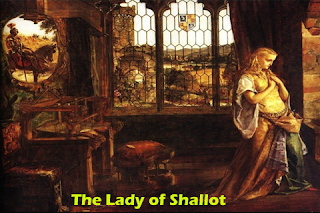Theme of Isolation in The Lady of Shallot
The Lady of Shallot is a representation of how Tennyson viewed society; the gap at which people are in the lady's eyes is symbolic of the gap he feels from society. The fact that she sees them only reflected through a mirror signifies the way in which Shallot and Tennyson see the world—in a filtered sense. This distance is therefore linked to the artistic license Tennyson often wrote about.
Alfred, Lord Tennyson’s poem presents a lady who is confined inside by a
magically imposed curse. She cannot leave her room and go outside, a situation
that increases her fascination with that alien world. The requirement that she
watch these goings-on only through the mirror imposes another layer of
separation: because she sees the world in reverse, her vision is distorted by
“shadows.” Her mission is to weave, but the subject matter she chooses is “the
mirror's magic sights.”
The impossibility of clear vision further isolates her from normal reality. In
particular, the Lady of Shallot watches the reflection of the traffic to and
from Camelot, King Arthur’s court, as the road which passes beneath her window.
The impressive figure of the great Sir Lancelot captures her fancy. It seems that
all her pent-up frustrations are condensed in her obsession with him, as she
thinks of herself as incomplete without a partner.
Isolation is omnipresent: in the world and among literature, as it is a
component of human nature. Although, sometimes, societal standards create
outcasts, isolation can be of one’s own making. Alfred, Lord Tennyson’s “The
Lady of Shallot is epitomizes isolation.
“Four gray walls, and four gray towers,
Overlook a space of flowers,
And the silent isle imbowers
The Lady of Shallot”
The Lady of Shallot is physically isolated in a tower, but upon her own accord for she fears to interact with the outside world due to a “whisper” that said she would be cursed if she paused her weaving to look outside at Camelot. So, she observes the town indirectly through a mirror only seeing shadows. Her weaving makes her happy but soon enough, she becomes, “half sick of shadows,” Once she hears Sir Lancelot sing, “Tirra lirra,” she leaves her art of weaving and breaks her isolation and the curse bestows her. She had isolated herself and diligently worked on her art: it is once Sir Lancelot comes that she risks the reality of the curse.
The Lady of Shallot can be interpreted as a symbol of artists and their commitment to their work, in this poem represented by weaving, but also paralleling Tennyson and his poetry. She sacrificed herself to her passion and ironically Sir Lancelot made her into nothing more than a piece of art, he said,
“She has a lovely face; /
God in his mercy lend her grace”
She can no longer weave “A magic web with colors gay,” rather, just be objectified into a dead-pale beauty not able to offer anymore creativity. The death of her artistic isolation led to the death of her creativity and ultimately herself.
Isolation is seemingly always negative, but the lady of Shallot offers a silver lining of the beauty of isolation when it involves the work of artists, by separating herself from the industrial society she was able to weave beautifully. The double wedged sword has the down side of a dark loneliness, which is at the heart of all isolation and caused her demise. J. Alfred Prufrock is another individual who chooses isolation but rather than be due to a curse he is damned with cognitive fallacies of self.
